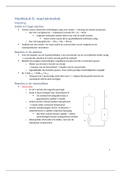B: Undertake calorimetry to study cooling curves
Keeping up the standards
Scenario
I am a freshly hired technical assistant as Chemcalequip, a huge chemical
company. I must demonstrate skills in a variety of practical procedures
and techniques as part of my induction time and to advance in my role.
One of my responsibilities is to guarantee that all equipment is calibrated,
and that all chemicals and equipment are safely checked for any
inconsistencies.
I must demonstrate my ability to acquire data using a calorimeter and
related equipment in order to determine, analyse, and evaluate the rate
at which substances cool.
Evidence of my practical skills, as well as my outcomes, calculations,
technique evaluations, and potential improvements will be required to be
given in reports.
Hypothesis
The solid stearic acid should be in a liquid format by the end of the
heating process, and about forty temperatures should be recorded every
sixty seconds / one minute. I also believe that halfway into the
experiment, the liquid stearic acid should be solidifying (when the heating
mantle is turned off), due to the temperature lowering down.
Cooling curve of stearic acid in air
Introduction
In this experiment, I will be using a pre-made apparatus, and heating up
some solid stearic acid with a process called calorimetry (not to be
confused with colorimetry). After the heating, we will be using a
thermometer to record the cooling of the stearic acid and using the data
we have recorded to produce a cooling curve. We will be using three
,kinds of substances: stearic acid, paraffin wax and beeswax, also we shall
be using two kinds of heating methods, a Bunsen burner, and a hot plate.
(However, during the third experiment I decided to keep the hot plate
and not change it to the Bunsen burner, this due to me being able to
obtain the most valid results. As I did not want to change too many
factors)
(Beeswax was not used, due to insufficient quantities being provided)
Paraffin wax is solid at room temperature, around 20°C, and also
flammable. I observed a white colour when in a liquid format and also a
translucent white when liquid. It has a melting point of about 48° to 66°C,
and a boiling point of 322°C.
Stearic acid is also a solid at room temperature, around 20°C, and also
flammable. I observed both white/yellowed tinge when solid, and a
translucent white when liquid. It has a melting point of about 69°C, and a
boiling point of about 361°C.
Aim
The whole purpose of this experiment is to produce and evaluate three
cooling curve graphs, and to also plot three tangents on one graph. To
achieve this, we can melt two different substances and measure the rate
that these cool, in both air and water.
Apparatus and Equipment
Safety –
Goggles
Laboratory coat (suitable size, buttoned up preferably)
Experiment –
Clamp stand, boss, and clamp stand
Heat proof mat
Hot plate
Alcohol thermometer (0-100°C)
Stopwatch or clock
, 250ml beaker
Boiling tube of solid steric acid (approx. 20g)
Tap water
For calibration
Container of ice
Kettle, boiling water
250ml beaker
Risk Assessment
Hazard Risk Level of Precautionary Emergency
Hazard Measures
Stearic acid Irritation High Wear a lab Wash eye
(solid and could coat. out at
liquid format) occur to Wear eye emergency
skin and protection. eye wash
to eyes. Avoid station.
Burns if touching Wash skin
liquid substance, immediately
steric acid in either after
is spilled. states of a contact.
solid and Swill out
liquid. mouth with
water if
swallowed.
Glassware Breakage Medium Make sure Do not
(beaker and – this that all touch
thermometer could lead glassware is glassware
) to the pushed to when
injury of the middle broken, find
persons. of the a suitable
workstation tool to clean
and is not up the
close to the mess,
edge. inform
Handle all superiors.
, glassware
with
caution.
Hot plate Burns – High When hot If a person
This could place is in is to come
lead to use, ensure into contact
the that it is with the hot
serious placed in the plate and
burn of an middle of suffers
individual, the burns, seek
if in workstation. medical
contact Ensure that advice.
with skin. hot plate is
switched off
immediately
after use.
General Trip – If Medium Make sure If an injury
Hazards chairs and that all occurs,
(Chairs and bags are chairs and inform the
Bags) to be bags are teacher.
tucked pushed Only
out. under perform
workstations first aid if
and not to necessary.
be outside
of this
allocated
area.
Calibration of the liquid filled thermometer





